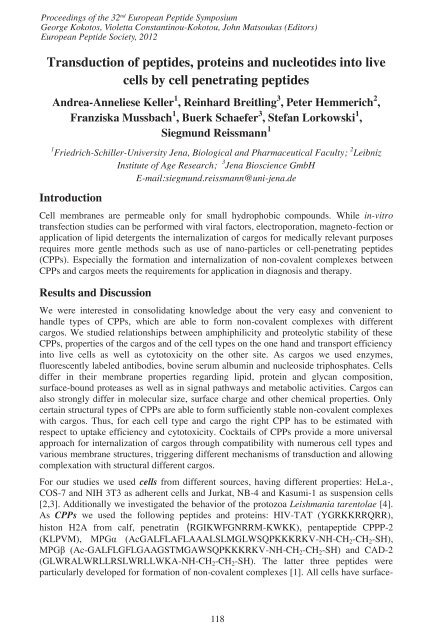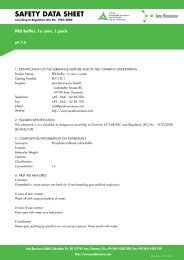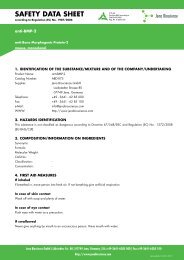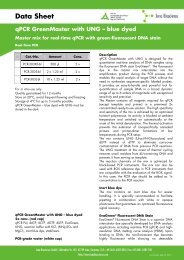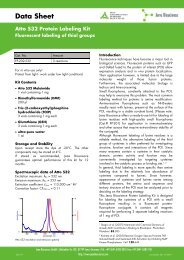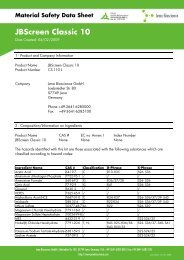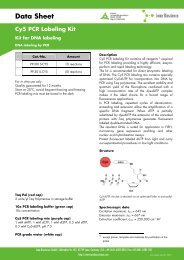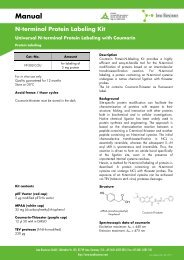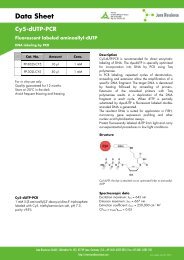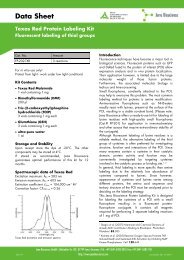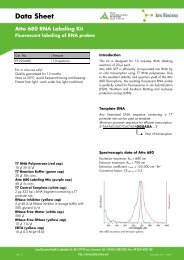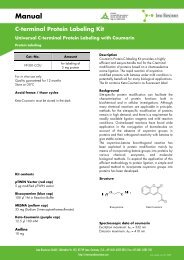Download PDF - Jena Bioscience
Download PDF - Jena Bioscience
Download PDF - Jena Bioscience
Create successful ePaper yourself
Turn your PDF publications into a flip-book with our unique Google optimized e-Paper software.
Proceedings of the 32 nd European Peptide Symposium<br />
George Kokotos, Violetta Constantinou-Kokotou, John Matsoukas (Editors)<br />
European Peptide Society, 2012<br />
Transduction of peptides, proteins and nucleotides into live<br />
cells by cell penetrating peptides<br />
Andrea-Anneliese Keller 1 , Reinhard Breitling 3 , Peter Hemmerich 2 ,<br />
Franziska Mussbach 1 , Buerk Schaefer 3 , Stefan Lorkowski 1 ,<br />
Siegmund Reissmann 1<br />
1 Friedrich-Schiller-University <strong>Jena</strong>, Biological and Pharmaceutical Faculty; 2 Leibniz<br />
Institute of Age Research; 3 <strong>Jena</strong> <strong>Bioscience</strong> GmbH<br />
E-mail:siegmund.reissmann@uni-jena.de<br />
Introduction<br />
Cell membranes are permeable only for small hydrophobic compounds. While in-vitro<br />
transfection studies can be performed with viral factors, electroporation, magneto-fection or<br />
application of lipid detergents the internalization of cargos for medically relevant purposes<br />
requires more gentle methods such as use of nano-particles or cell-penetrating peptides<br />
(CPPs). Especially the formation and internalization of non-covalent complexes between<br />
CPPs and cargos meets the requirements for application in diagnosis and therapy.<br />
Results and Discussion<br />
We were interested in consolidating knowledge about the very easy and convenient to<br />
handle types of CPPs, which are able to form non-covalent complexes with different<br />
cargos. We studied relationships between amphiphilicity and proteolytic stability of these<br />
CPPs, properties of the cargos and of the cell types on the one hand and transport efficiency<br />
into live cells as well as cytotoxicity on the other site. As cargos we used enzymes,<br />
fluorescently labeled antibodies, bovine serum albumin and nucleoside triphosphates. Cells<br />
differ in their membrane properties regarding lipid, protein and glycan composition,<br />
surface-bound proteases as well as in signal pathways and metabolic activities. Cargos can<br />
also strongly differ in molecular size, surface charge and other chemical properties. Only<br />
certain structural types of CPPs are able to form sufficiently stable non-covalent complexes<br />
with cargos. Thus, for each cell type and cargo the right CPP has to be estimated with<br />
respect to uptake efficiency and cytotoxicity. Cocktails of CPPs provide a more universal<br />
approach for internalization of cargos through compatibility with numerous cell types and<br />
various membrane structures, triggering different mechanisms of transduction and allowing<br />
complexation with structural different cargos.<br />
For our studies we used cells from different sources, having different properties: HeLa-,<br />
COS-7 and NIH 3T3 as adherent cells and Jurkat, NB-4 and Kasumi-1 as suspension cells<br />
[2,3]. Additionally we investigated the behavior of the protozoa Leishmania tarentolae [4].<br />
As CPPs we used the following peptides and proteins: HIV-TAT (YGRKKRRQRR),<br />
histon H2A from calf, penetratin (RGIKWFGNRRM-KWKK), pentapeptide CPPP-2<br />
(KLPVM), MPGα (AcGALFLAFLAAALSLMGLWSQPKKKRKV-NH-CH2-CH2-SH),<br />
MPGβ (Ac-GALFLGFLGAAGSTMGAWSQPKKKRKV-NH-CH2-CH2-SH) and CAD-2<br />
(GLWRALWRLLRSLWRLLWKA-NH-CH2-CH2-SH). The latter three peptides were<br />
particularly developed for formation of non-covalent complexes [1]. All cells have surface-<br />
118
ound proteolytic activities and hydrolyze the CPPs. Thus, intact HeLa-, NIH 3T3-cells and<br />
Leishmania degrade penetratin completely within 60 minutes [4]. The used CPPs are<br />
differently hydrophobic and show different proteolytic stabilities. CAD-2 is the most<br />
hydrophobic peptide and is more resistant to proteolytic degradation than other used CPPs<br />
[4]. We also found a cargo-dependent uptake. Thus, the CPPs trigger the uptake of the<br />
high molecular weight enzyme β-galactosidase into HeLa-cells in the following rank order:<br />
Proteoducin > MPGα ≥ MPGβ > CAD-2 >> CPPP-2. For the uptake of the fluorescently<br />
labeled nucleotide ATTO488-dUTP into HeLa-cells we found another order: CAD-2 ><br />
MPGα ≥ MPGβ > penetratin >> CPPP-2 [2,3]. Due to different membrane properties and<br />
the transport mechanisms the uptake efficiency is cell-dependent [4]. CPPs are in many<br />
cases able to transduce even very difficult to transfect cells such as Kasumi-1 cells [3].<br />
Leishmania tarentolae can be transduced with β-galactosidase and with ATTO488-BSA<br />
[4]. CPPs can have special localization sequences. Thus, MPGα, H2A and MPGβ are able<br />
to transport the fluorescent protein ATTO488-BSA into the nucleus and the kinetoplast of<br />
Leishmania. Quantitative uptake efficiencies were estimated by fluorescence<br />
measurements and with calibrated SDS-PAGE. Intracellular amounts depend on the cell<br />
volume and can reach the amole range. Intracellular concentrations come to the low<br />
micromolar range [3,4]. Cytotoxic effects depends on the cell-type and CPP used [2,3,4].<br />
Quantitative Uptake Efficiencies<br />
Amount of added complex<br />
Internalized amount<br />
(0.3 x 10<br />
per 1.6 ml serum-free medium<br />
6 HeLa-cells per well)<br />
amol per cell<br />
Intracellular<br />
concentration in µM<br />
ATTO488-deoxyuridine triphosphate into HeLa-cells<br />
1 µg + JBS-Nucleoducin, charge by charge 1:4 1.1 0.1<br />
ATTO488-bovine serum albumin into HeLa-cells<br />
10 µg + JBS-Proteoducin, molar ratio 1:10 20<br />
25 µg + JBS-Proteoducin, molar ratio 1:10 50 4.3<br />
FITC-antibody (secondary) into HeLa-cells<br />
5 µg + JBS-Proteoducin, molar ratio 1:10 0.4<br />
25 µg + JBS-Proteoducin, molar ratio 1:10 4.3 0.6<br />
ATTO488-bovine serum albumin into Leishmania tarentolae<br />
5 µg + MPGα, molar ratio 1:10 1.7 x 10 -2<br />
0.1<br />
10 µg + MPGα, molar ratio 1:10 3.3 x 10 -2<br />
0.2<br />
CPPs and cocktails of them allow cellular uptake of kinases, phosphatases, deacetylases,<br />
proteases, small GTPases, activity modulators and as well as substrates and inhibitors of<br />
enzymes as tools for signal pathway studies and for therapeutically use. Internalized<br />
antibodies act more specifically than inhibitors of kinases or mono-valent ligands for<br />
protein binding domains and can compete with RNA silencing techniques.<br />
References<br />
[1] Deshayes, S., Morris, M., Heitz, F., Divita, G. Adv. Drug Deliv. Rev. 2008, 60, 537.<br />
[2] Mussbach, F.; Pietrucha, R.; Schaefer, B.; Reissmann, S. Meth. Mol. Biol. 2011, 683, 375.<br />
[3] Mussbach, F.; Franke, M.; Zoch, A.; Schaefer, B.; Reissmann, S. J. Cell. Biol. 2011, 112, 3824.<br />
[4] Keller, A.-A. et al., Pharmaceuticals, 2012, Issue:‖Cell-penetrating Peptides‖, submitted.<br />
119


